In what has become an annual tradition, the time has come for my positional ranking series. I use the past three seasons worth of statistics to create a model of sorts to weight as many facets of the game of hockey as possible, then create a somewhat objective valuation of the total impact NHL players have relative to their peer groups.
This is the third year I’ve spent the summer crunching numbers to come up with these rankings, and like the previous two, we’ll be starting with centres. You can check out 2016’s list here and 2017’s list here.
Also like the past two years, I owe a lot of thanks for this project to others in the hockey analytics field, such as Emmanuel Perry, Dom Luszczyszyn, Steve Burtch, Dominic Galamini Jr., and Tyler Dellow. Their help along the way directly and indirectly influenced this project.
Statistics for this project were collected from SPORTLOGiQ, Natural Stat Trick, Corsica, Puck IQ, Hockey Reference, the NHL’s official website, and Dom Luszczyszyn’s Game Score database.
This year, in order to get a larger sample size to work with, I lowered the barrier of eligibility for the rankings from 2000 5-on-5 minutes over three seasons, to 2000 minutes overall. This helped to include some promising young players, but there are still rookies from last year who won’t make the cut, most notable being Matt Barzal , who could very well show up on next season’s top-20 centres list. In all, 125 centres qualified for the project.
The weighting of the categories for centres remains the same as last season: 50 for offence, 25 for transition, and 25 for defence, though some new statistics have been added, and the difficulty of minutes adjustment has been changed.
Previously, players could be awarded a maximum of a 25 per cent boost to their score based on the difficulty of their minutes, but that’s been changed to 30 per cent this season. The mean score for each position was taken and deducted from each player’s difficulty score – this means a player’s score could be boosted or knocked down depending on the difficulty of the minutes they were assigned. The difficulty adjustment is already applied to the numbers shown and in the graphics.
[snippet ID=3322139]
Each season was weighted so that recent seasons account for more of a player’s total score: 22.2 per cent from 2015-16, 33.3 per cent from 2016-17, and 44.5 per cent from 2017-18. But if a player only played in two of those years, they would see a weighting of 42.8 per cent for 2016-17, and 57.8 per cent for 2017-18.
Here are the statistics used in each category:
Offence: 5-on-5 and power play goals, primary assists, secondary assists, high danger scoring chances, scoring chances, passes to the slot, scoring chances off the rush, passes off the rush, rebound recoveries, scoring chance generating plays, shot attempts, penalties drawn, on-ice goals for relative to teammates (all per 60 minutes), and offensive zone pass completion rate.
Transition: 5-on-5 outlet passes, stretch passes, controlled carries out of the defensive zone, neutral zone passes forward and east-west, controlled entries into the offensive zone (all per 60 minutes), Corsi for percentage, Corsi for percentage relative to teammates, faceoff win percentage by zone, controlled exit rate relative to teammates, controlled entry rate relative to teammates, outlet, stretch, and neutral zone pass completion rates relative to teammates.
Defence: 5-on-5 and shorthanded loose puck recoveries by zone, blocked passes, stick checks, body checks, blocked shots, puck battles won, penalties taken, on-ice goals against relative to teammates, on-ice shot attempts against relative to teammates, on-ice passes to the slot against relative to teammates, on-ice high danger chances against relative to teammates (all per 60 minutes), turnover rate by zone relative to teammates.
Degree of difficulty: Puck IQ’s competition faced percentages (2016-17 only), Game Score’s quality of forwards faced, Game Score’s quality of defencemen faced, Game Score’s quality of teammate forwards, Game Score’s quality of teammate defencemen, Corsi quality of competition, Corsi quality of teammates, time on ice quality of competition, time on ice quality of teammates, personal shooting percentage relative to career average, on-ice shooting percentage, on-ice save percentage, defensive zone starts percentage, 5-on-5 ice time, and overall ice time per game.
There’s a slight change to the charts this year as well. I’ll be showing how players rank both in percentile form, a straight up “what percentage of their peers are they ahead of” and also the percentage that the player impacts a category compared to the best player at their position, which I’m calling per cent of peak. For example Oscar Lindberg’s offensive impact is 32 per cent of Connor McDavid’s.
Let’s get into it.
20. Vincent Trocheck
Difficulty adjustment: +3.14%
Offence: 24.71/50 | Transition: 15.62/25 | Defence: 13.63/25
Total: 53.95/100

Despite having career-high offensive totals, Trocheck’s defensive play was less impressive last season, and that knocked him down the rankings from 13th to 20th. But he remains a mostly-hidden gem of a player who excels almost equally in all aspects of the game. Trocheck stays at or above the first line centre mark in each area, playing tough minutes without any glaring weaknesses.
His biggest strengths are in his transition play, where he’s a premier controlled exit and entry machine, which has helped him to be a bit of a one-man wrecking crew with subpar linemates. He’s likely to see a big upgrade there this season with Mike Hoffman and Jonathan Huberdeau expected to flank him.
19. David Krejci
Difficulty adjustment: -0.17%
Offence: 24.59/50 | Transition: 15.98/25 | Defence: 13.51/25
Total: 54.08/100
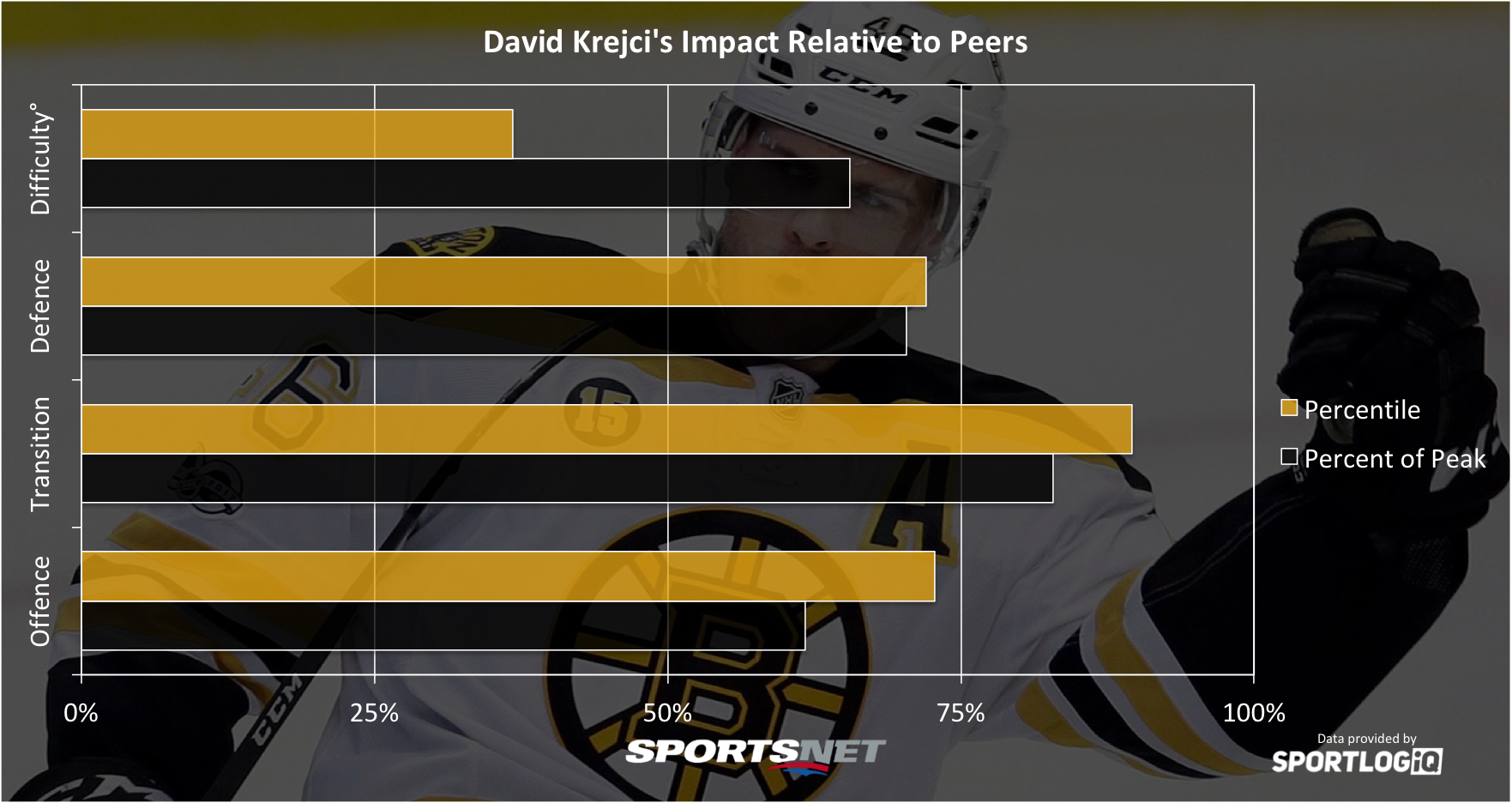
Every year I expect to see Krejci fall down the rankings as younger players jump up, but he manages to hold on for at least one more year. Always in Patrice Bergeron’s shadow, Krejci has seen his offensive numbers slip a bit in his early-30s, which combines with the fact that he doesn’t get the highest quality wingers anymore.
Krejci is a strong puckhandler, but his passing has enabled him to remain a top-end transition player while slowing down slightly due to age. Krejci boasts one of the best pass success rates relative to his team of any centre in the league – he’s able to find quick players such as Jake DeBrusk in stride to attack off the rush. Krejci’s presence as a safety net and transition player was a big reason why DeBrusk was able to have such a strong rookie campaign.
18. Jonathan Toews
Difficulty adjustment: +2.35%
Offence: 24.84/50 | Transition: 16.71/25 | Defence: 12.89/25
Total: 54.44/100

Toews has gone from one of the NHL’s most overrated forwards to one of the more underrated. After his effectiveness dropped off in a serious way in 2015-16, he’s shown incremental improvement the past two seasons despite having the two worst shooting percentage years of his career.
At 30 years old, Toews likely won’t recapture his youth, but he’s a smart player who contributes more than goals and assists. If the Blackhawks around him improve, he could be a candidate for a comeback season, which he likely would have had in 2017-18 if Brandon Saad didn’t have one of the most snake-bitten seasons in recent memory. As Toews has aged, he has leaned more heavily on playmaking than shooting, and he had phenomenal passing numbers last year, but he needs someone on his wing to put those passes home. Could that player be Alex DeBrincat?
17. Evgeny Kuznetsov
Difficulty adjustment: +0.61%
Offence: 32.02/50 | Transition: 13.88/25 | Defence: 10.26/25
Total: 56.16/100

Ranked in the same spot as last season, it would be logical to say Kuznetsov may have plateaued, but he’s actually slightly better in each area of the game – it’s just that the competition got even tougher at the centre position. Getting more time with Alex Ovechkin was a mutually beneficial situation in 2017-18, leading to an offensive explosion for Kuznetsov, who posted a career high in points and goals.
Kuznetsov has a reputation as a transition player, mainly because he’s one of the most dynamic puck carriers in the game who creates more offence off the rush than almost anyone. He played a huge part in revitalizing Ovechkin’s goal scoring last year, but Kuznetsov’s passing outside the offensive zone is not the best. Defensively, Kuznetsov leaves a lot to be desired at 5-on-5, but I think his speed and agility could be a nice addition to Washington’s penalty killing this season.
16. Leon Draisaitl
Difficulty adjustment: +0.96%
Offence: 28.49/50 | Transition: 16.92/25 | Defence: 12.25/25
Total: 57.66/100

Draisaitl still hasn’t played an entire season as a full-time NHL centre, so it’s extremely difficult to separate his play from McDavid’s. But after a second straight 70-point season and improvement across the board, Draisaitl moves up the rankings.
One of the most impressive players in the league with the puck on his stick in the neutral zone, Draisaitl is among the NHL’s elite zone entry players, and is equally dangerous passing or shooting. One of the reasons the Oilers have been so hesitant to split him from McDavid is that he’s able to keep up in both transition and offensive conversion. Draisaitl has some weaknesses on the defensive side, but he’s a player to watch over the next few years.
15. Mark Scheifele
Difficulty adjustment: +2.83%
Offence: 29.47/50 | Transition: 14.89/25 | Defence: 13.43/25
Total: 57.79/100

Despite a point-per-game season, Scheifele has dropped five spots from last season’s ranking because many of his underlying numbers took a hit. Two seasons ago Scheifele was among the best players in the league at generating high quality shots for himself, but he has drifted further from the net in each subsequent season.
That hasn’t hurt his goal scoring yet, partly due to Blake Wheeler’s stellar playmaking, but I think Scheifele is capable of greater heights than he showed in 2017-18 if he can commit to better puck management. Scheifele is one of the most active defensive centres in the NHL without the puck, recovering loose pucks at a high rate. But he was a bit of a turnover machine outside of the neutral zone, which led to huge drops in defensive results in terms of shot attempts and scoring chances against. Scheifele is a game breaking talent, and I don’t think we’ve seen his best season yet.
14. Steven Stamkos
Difficulty adjustment: -0.66%
Offence: 34.30/50 | Transition: 14.03/25 | Defence: 9.56/25
Total: 57.89/100

Stamkos’ drop from his No. 7 ranking is mostly attributable to the fact the 2014-15 season is no longer being considered here, but his goal scoring decline is a culprit as well. Stamkos makes smart decisions in transition, but he’s not as involved in moving the puck as you would expect. He prefers to dish off to teammates, but carries low pass success rates and high turnover rates on those plays, which leads to a lot of possession changes when he’s on the ice.
Unfortunately, Stamkos wasn’t a big puck retriever or an active defender last season, which meant his line essentially had to rely on scoring its way out of trouble, and Nikita Kucherov was arguably a bigger factor there. Stamkos remains one of the most dangerous power play weapons and overall snipers of his generation, but for the Lightning to get over the hump, he may need to be a bit more aggressive without the puck. Stamkos should be given incredible amounts of credit for being able to transition from an elite scorer to an elite playmaker, but you have to think he’s at his best when he scores more.
13. Ryan O’Reilly
Difficulty adjustment: +7.62%
Offence: 25.02/50 | Transition: 16.74/25 | Defence: 18.33/25
Total: 60.09/100

Last season no centre in the NHL played tougher minutes than O’Reilly, who had a combination of brutal quality of teammates, tough deployment in terms of competition and zone starts, and some bad on-ice percentages mixed in. Despite all that, and apparently losing his love of the game, he managed a 61-point season and was a defensive force on a team that didn’t defend very well. Perhaps most impressive is how few penalties O’Reilly takes when defending, since the relative weakness of his team the past three years forced him to play without the puck a ton.
O’Reilly is a perfect example of a player who does everything you could possibly want outside the offensive zone. And despite not being the most dynamic offensive player, the less flashy work he puts in results in first line level offence anyway. If last year was a down year for O’Reilly, St. Louis got a gem of a player.
12. John Tavares
Difficulty adjustment: +4.84%
Offence: 30.55/50 | Transition: 15.70/25 | Defence: 13.89/25
Total: 60.14/100
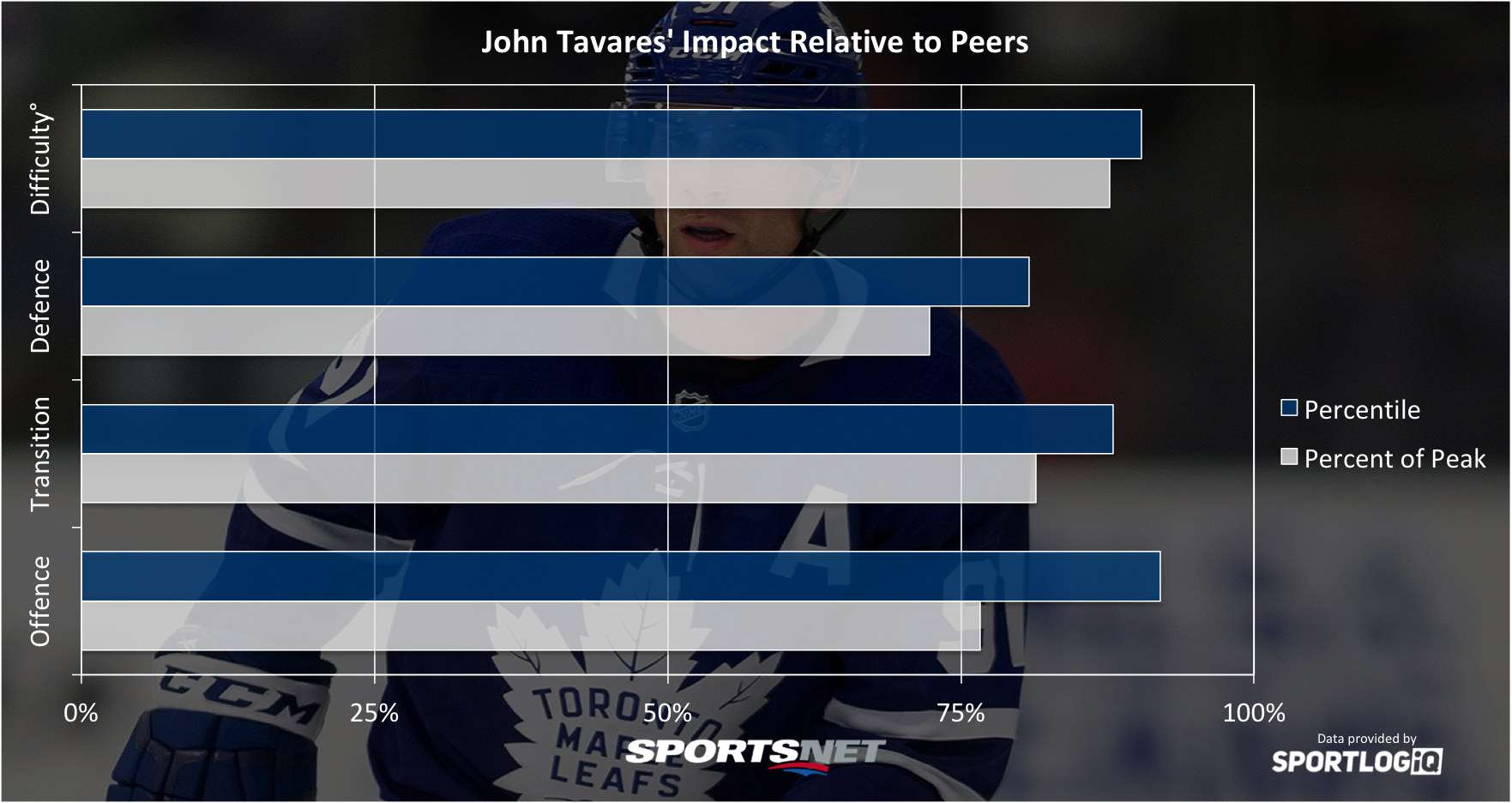
Tavares was ranked sixth heading into the 2017-18 season, but the massive strides he had taken the season prior in defence and transition withered away under the weight of the Islanders’ disastrously disorganized play when they weren’t in the offensive zone.
Tavares wasn’t nearly as involved in stripping opponents of possession or recovering loose pucks last season. He was also a bit porous in letting passes through the slot area in his own zone, which combined for a lot of goals against while he was on the ice. Offensively he’s as great as ever, and with a more structured team in Toronto where Matthews and Kadri will take some checking minutes, I expect a huge bounce back campaign for Tavares.
[snippet id=3816507]
11. Nicklas Backstrom
Difficulty adjustment: +0.72%
Offence: 26.83/50 | Transition: 16.97/25 | Defence: 16.37/25
Total: 60.17/100

For the first time in a long time, Nicklas Backstrom and Alex Ovechkin weren’t an inseparable pair last season, and while some assumed Backstrom wouldn’t be as effective without his long-time winger, he remained one of the most consistent offensive forces in the league.
Backstrom did see his overall point production drop a bit, but that was mostly on the power play. He remains one of the most impressive scoring chance and goal producers in the NHL on the man advantage, he just had some bad luck beating goalies and many of his passes ended in misfired shots. Backstrom’s passing brilliance extends to all zones, where he boasts one of the highest success rates in the NHL both relative to his teammates and in raw form. His low number of turnovers combined with an underrated ability to win puck battles makes him an excellent two-way player.
10. Jack Eichel
Difficulty adjustment: +6.44%
Offence: 31.46/50 | Transition: 16.51/25 | Defence: 12.82/25
Total: 60.78/100
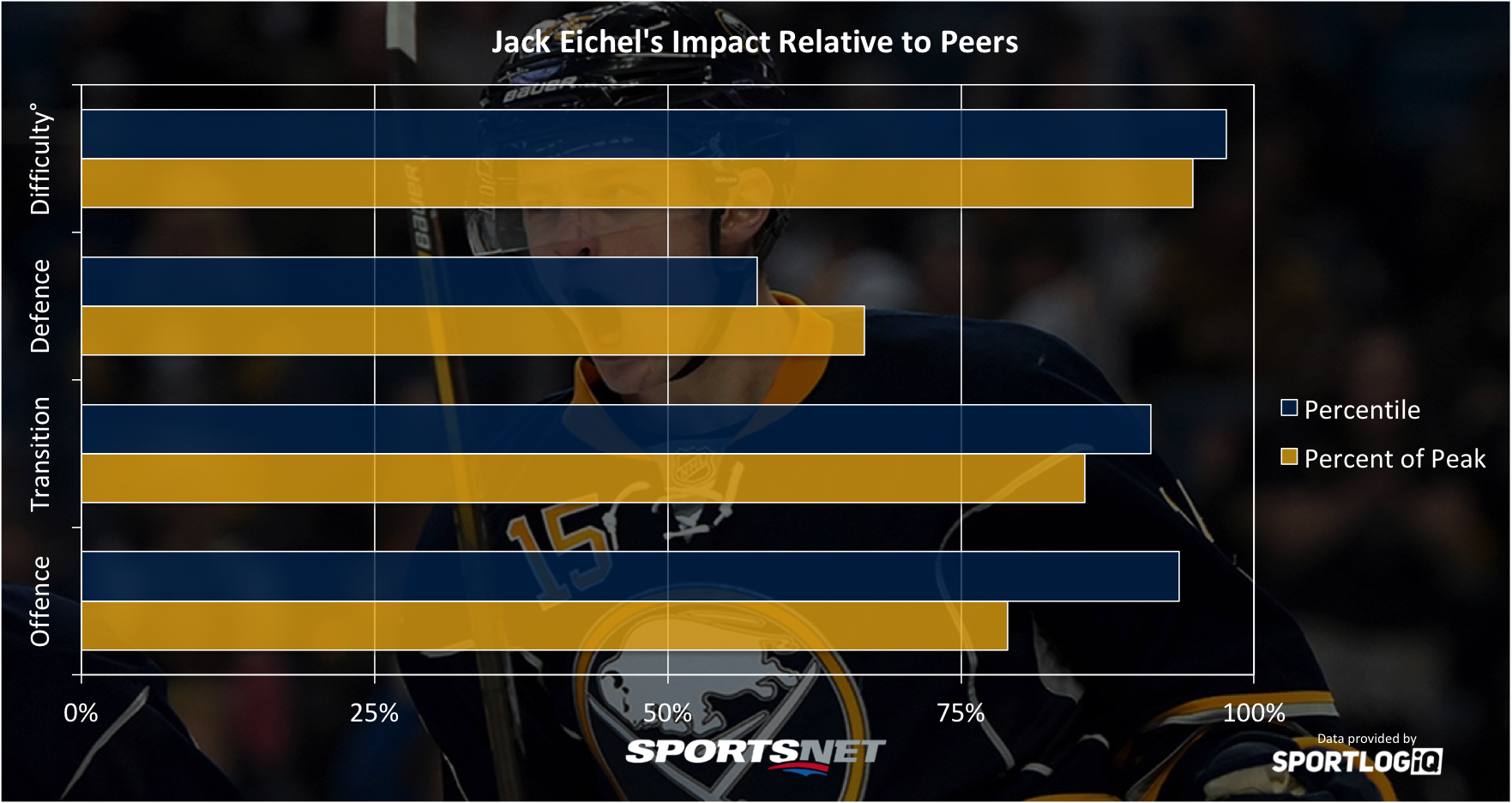
Playing in front of that Sabres defensive group, with poor quality wingers outside of Evander Kane, it’s been very tough for Eichel to appear as the star player he is. He needs to get more involved defensively when opponents have the puck, but he’s doing the right things everywhere else.
Eichel is a puck retrieval monster, keeps turnovers low in the defensive zone, exits the defensive zone with control more often than any other player, and is only bested by McDavid in overall plays that move the puck up the ice. Eichel’s incremental improvements show up each season, with last year finally showing him as a possession driver. The next area I expect to see him improve is turning his nearly league high scoring chance generation on the power play into actual point production. Eichel is doing his part; the Sabres have to do the rest.
[relatedlinks]
9. Ryan Getzlaf
Difficulty adjustment: +3.33%
Offence: 28.62/50 | Transition: 16.77/25 | Defence: 16.16/25
Total: 61.55/100
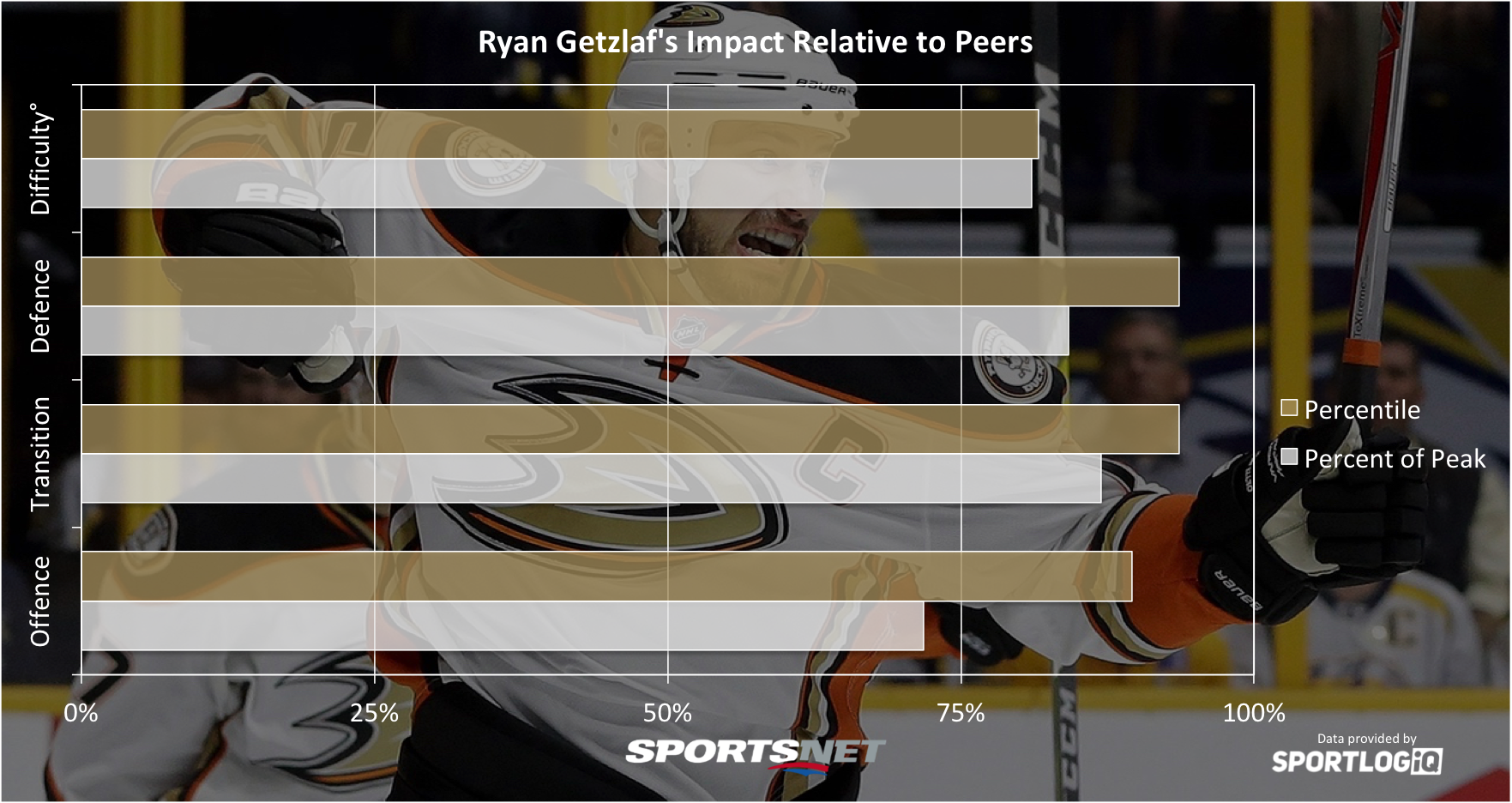
Every year I think about Getzlaf’s lack of foot speed, history of playing with and missing time to injuries and think “Maybe this is the year he falls off” — and every year he doesn’t. A truly complete player, Getzlaf is one of very few players who can put up above average first line offence without scoring 20 goals himself. Heck he hasn’t even scored 15 in two of the past three years.
Getzlaf’s lack of speed should hold him back in transition, but it doesn’t; he’s shifty enough to break away from players with his stickhandling instead of his skating, and strong enough to hold off players who do catch him to make crisp passes to teammates that rarely end up as turnovers. His strength and reach also make him a daunting player in puck battles, with more wins than almost any other forward in the league the past three seasons.
8. Nathan MacKinnon
Difficulty adjustment: +4.88%
Offence: 36.64/50 | Transition: 15.85/25 | Defence: 11.09/25
Total: 61.58/100

While MacKinnon’s point production didn’t rise significantly from 2015-16 to 2016-17, he massively improved his game in other areas. Mikko Rantanen’s breakout season in 2017-18 allowed MacKinnon to offload some of the stress of having to carry Colorado’s transition game and they became one of the fastest and most dangerous offensive duos in the league.
Mackinnon’s offensive impact in 2017-18 was actually the largest in the NHL, but what held him back was a lack of improvement in his defensive game. He saw some drops in defensive involvement both in removing possession from opponents and in gaining possession of loose pucks. He’s no longer the liability he was in his first couple seasons, but there’s still lots of room to grow.
7. Anze Kopitar
Difficulty adjustment: +2.81%
Offence: 26.44/50 | Transition: 19.29/25 | Defence: 16.73/25
Total: 62.46/100

A bounce back year of epic proportions shoots Kopitar back into the league’s top-10 centres. With Jeff Carter missing nearly 60 games, and Tyler Toffoli’s career hitting a bump in the road, Kopitar had even more on his shoulders last season and, luckily for the Kings, he rekindled some magic with Dustin Brown to make life a little easier.
The magic to Kopitar’s game is shockingly similar to that of teammate Drew Doughty; they make a metric ton of passes, and they just don’t miss them. Kopitar is always moving the puck forward, and no one succeeds at connecting passes as often as he does. Combine that with being one of the most efficient players in the league at gaining the offensive zone and you have a player who creates above league average offence before he even enters the offensive zone.
6. Patrice Bergeron
Difficulty adjustment: -0.86%
Offence: 28.15/50 | Transition: 15.17/25 | Defence: 19.19/25
Total: 62.51/100

Bergeron gets tough deployment, but playing consistently with Marchand and Pastrnak is an incredible boost to his game and this is why his degree of difficulty looks so skewed compared to what you would expect. Even with some points shaved off though, Bergeron remains one of the most impactful centres in the game by every measure, topping all centres in defensive impact for the third straight year.
What’s incredible about Bergeron is despite age and injuries working against him, there’s virtually no fall off to his game in any area — he’s just Patrice Bergeron every year, putting up fantastic numbers, forever flirting with between 25 and 30 goals. He may not be flashy, but he is relentless with and without the puck.
5. Auston Matthews
Difficulty adjustment: +0.52%
Offence: 34.68/50 | Transition: 14.43/25 | Defence: 13.70/25
Total: 62.82/100

It should come as no surprise that the highest debut on the list this year is Maple Leafs superstar Auston Matthews who, despite battling injury at the end of last season, improved his play in every area.
Matthews is the NHL’s new gold standard for even strength goals and scoring chances, and he’s able to do that while maintaining nearly elite level playmaking as well. He’s also one of the NHL’s best puck retrievers and puck battle winners, but he can improve at stopping passes through the slot in his own zone, and needs to have the confidence to handle the puck more outside the offensive zone, where his plays are smart but too infrequent.
4. Aleksander Barkov
Difficulty adjustment: +0.97%
Offence: 29.61/50 | Transition: 18.05/25 | Defence: 17.11/25
Total: 64.76/100
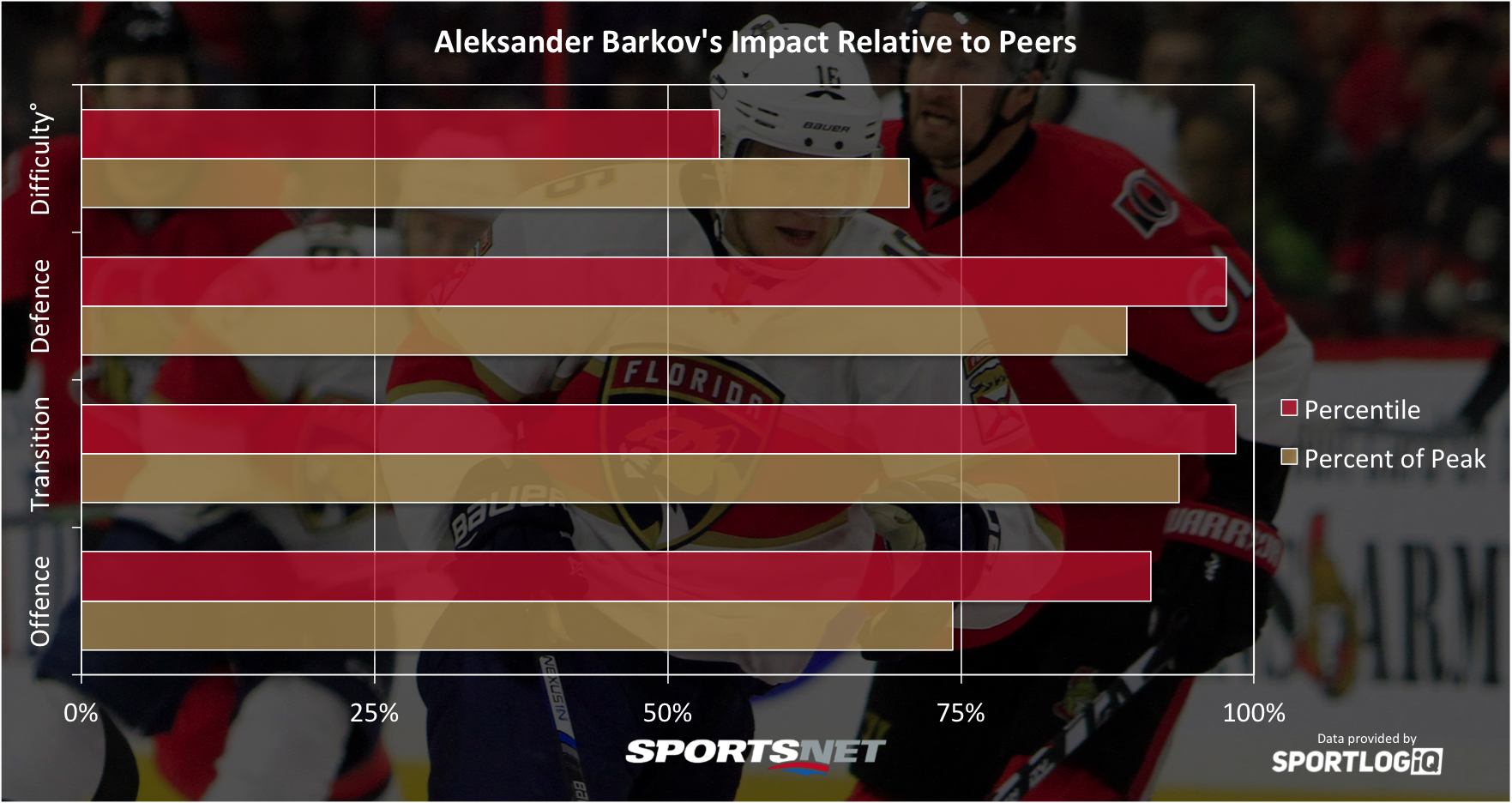
If you were asked to name a player who didn’t have any flaws in their game, you’d be hard pressed to find a better answer than Barkov. He is perfectly balanced. If you were looking extra critically, one nitpick could be that he could do a better job stopping passes through the middle in his own zone, but he’s still about league average in that area.
Barkov’s standout skills are similar to Kopitar’s: he’s a phenomenal passer in every zone, rarely makes mistakes and is not afraid to throw a saucer pass over a couple sticks in a dangerous area in order to gain territorial advantage. What particularly impressed me about Barkov last year is that he lost his two most consistent linemates in Jaromir Jagr to free agency then retirement, and Jonathan Huberdeau to teammate Vincent Trocheck on the second line, and Barkov just kept going like clock work. He’s a special player.
3. Sidney Crosby
Difficulty adjustment: +3.68%
Offence: 35.26/50 | Transition: 16.86/25 | Defence: 13.37/25
Total: 65.48/100

I know a lot of fans will likely be upset that Crosby is ranked “way down” at third place, but he had a bit a rough season last year — for Sidney Crosby anyway. While he was downright dominant on the power play, Crosby dealt with a season-long cold streak at 5-on-5 that broke in the playoffs, where he was phenomenal.
Crosby also saw hits to his transition and defensive numbers, where he struggled to make defensive zone passes consistently, and he wasn’t very involved in actively defending opponents when they had possession compared to his usual levels.
I’ve speculated before that maybe he was saving energy for the playoffs, but it would be 1) unfair to account that for him and not other players and, 2) probably impossible to accurately do anyway. I’m sure the Penguins aren’t too upset that an off year for Sid is 29 goals and 89 points.
2. Evgeni Malkin
Difficulty adjustment: -0.20%
Offence: 35.07/50 | Transition: 17.29/25 | Defence: 13.80/25
Total: 66.15/100
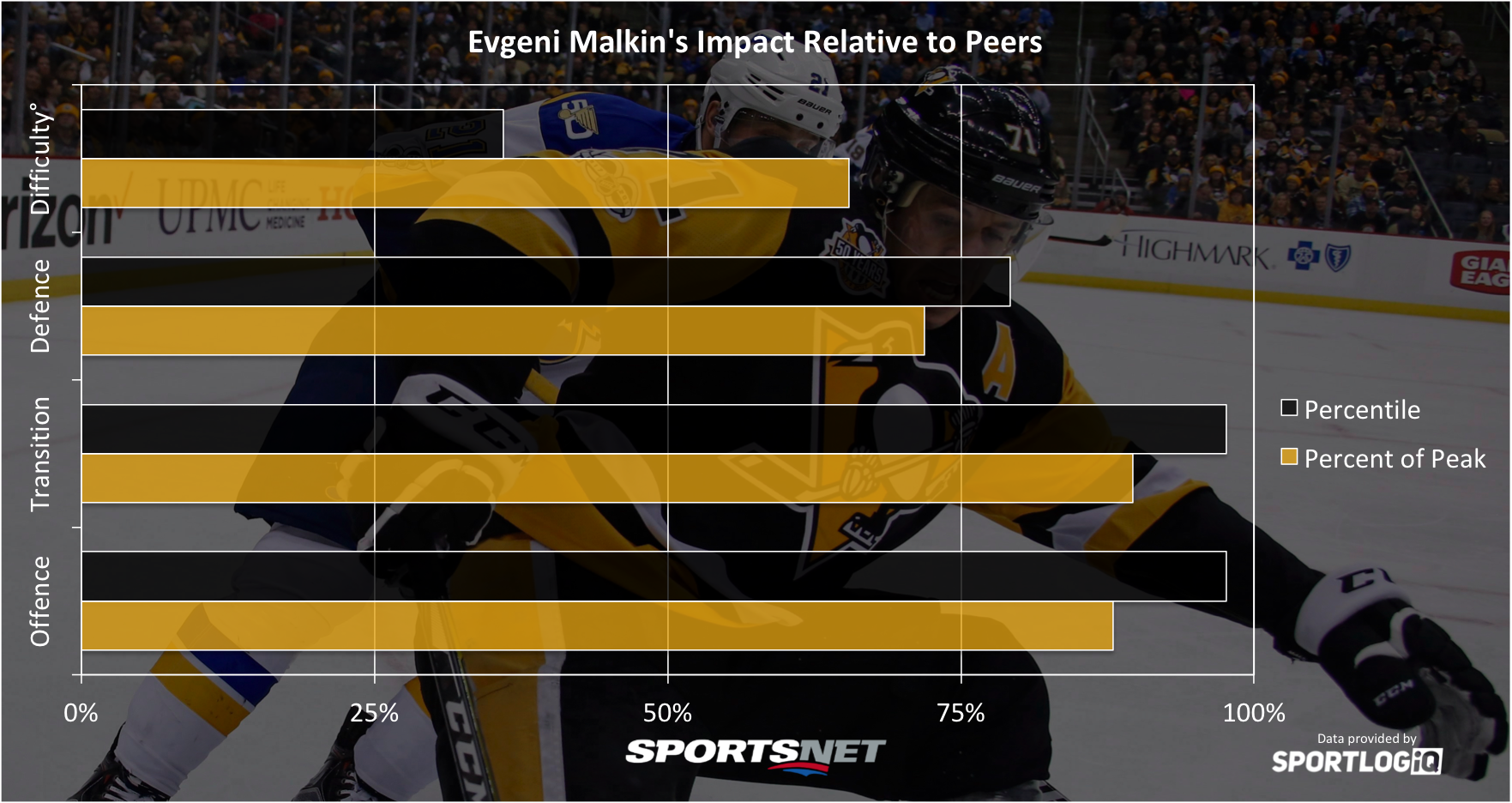
Playing behind Sidney Crosby has its advantages, such as rarely seeing top checkers and often getting the better linemates since Crosby can make late-30’s Chris Kunitz into a first line player. But it also comes with people underrating your play enough that you don’t get named to the top-100 NHLers of all time even though you clearly should have been.
Malkin is controlled chaos unleashed on opponents who still can’t figure out how to shut him down after 11 seasons. He can be a little haphazard at times in the defensive zone, though. He is caught running around a little, which leaves him susceptible to passes through the middle, but he makes up for it with both his offensive game and a superb ability to move the puck up the ice with a unique combination of stickhandling, speed, and brute force.
1. Connor McDavid
Difficulty adjustment: +5.57%
Offence: 39.85/50 | Transition: 17.28/25 | Defence: 13.79
Total: 70.92

There was never any doubt who would be here. McDavid somehow continues to improve despite the Oilers taking a huge step back last season. But one area he saw a deterioration in was his defensive play, and that was mostly due to the Oilers’ awful penalty kill, which brought him down from being one of the league’s biggest standout penalty killers in 2016-17 to outright bad in 2017-18.
McDavid is already the most impactful offensive player in the NHL, and he hasn’t even been that effective on the power play yet. I think this is what should scare every team in the NHL about him: you already know he’s the best player at even strength, but do you think he’ll always struggle on special teams? He’s far too smart and skilled to, and once he figures those out… Yikes.







